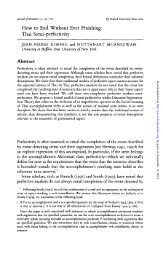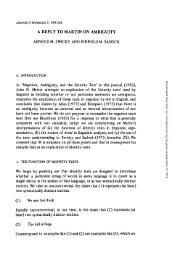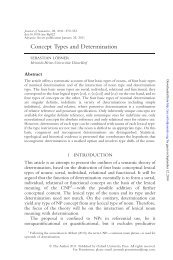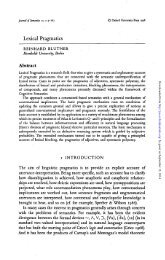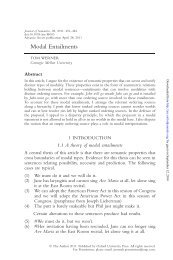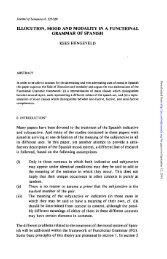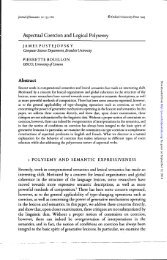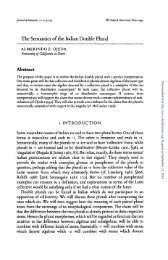Exclusive Company: Only and the Dynamics of Vertical Inference ...
Exclusive Company: Only and the Dynamics of Vertical Inference ...
Exclusive Company: Only and the Dynamics of Vertical Inference ...
You also want an ePaper? Increase the reach of your titles
YUMPU automatically turns print PDFs into web optimized ePapers that Google loves.
12 <strong>Only</strong> <strong>and</strong> <strong>the</strong> <strong>Dynamics</strong> <strong>of</strong> <strong>Vertical</strong> <strong>Inference</strong><br />
Thus, a claim about only + CN is simply not equivalent to a claim about all<br />
<strong>and</strong> only <strong>the</strong> members <strong>of</strong> a given set, a fact rendered explicitly in (28a),<br />
excerpted from an Internet posting on lactose intolerance:<br />
(28) a. <strong>Only</strong> humans <strong>and</strong> not even all humans are genetically equipped to<br />
drink milk into adulthood,<br />
b. Humans are genetically equipped to drink milk into adulthood.<br />
The corresponding claim in <strong>the</strong> prejacent, (28b), is not interpreted existentially<br />
but universally or at least generically, <strong>and</strong> again represents a stronger commitment<br />
than is licensed by <strong>the</strong> assertion <strong>of</strong> (28a).<br />
Of course, an individual-level only predication may be consistent with <strong>the</strong><br />
corresponding all <strong>and</strong> only statement, as in (29), but <strong>the</strong> point is that (29b, c) are<br />
not valid consequences <strong>of</strong> (29a), even though <strong>the</strong>y happen to be true. What<br />
follows from (29a) is not (29b) or (29c), but (29d). 17<br />
(29) a. <strong>Only</strong> birds have fea<strong>the</strong>rs.<br />
b. All birds have fea<strong>the</strong>rs.<br />
c. All <strong>and</strong> only birds have fea<strong>the</strong>rs.<br />
d. All fea<strong>the</strong>red things are birds.<br />
In recognizing <strong>the</strong> mutual convertibility <strong>of</strong> exclusives <strong>and</strong> universals, we<br />
obtain <strong>the</strong> equivalences <strong>of</strong> (30), preserving monotonicity orientations for <strong>the</strong><br />
corresponding argument positions as indicated. 18<br />
(30) a. only As are Bs all BsareAs every (B)(A)<br />
*— DE environments —'<br />
non-DE environments —I<br />
Finessing <strong>the</strong> issue <strong>of</strong> existential import, only behaves like an upward monotone<br />
determiner that combines with a focus argument to form a downward<br />
monotone quantifier, while every /all is a downward monotone determiner that<br />
combines with a restrictor to form an upward monotone quantifier. We can<br />
represent <strong>the</strong> correspondence in (30) schematically by three-dimensionalizing<br />
<strong>the</strong> traditional Aristotelian square <strong>of</strong> opposition:<br />
Downloaded from http://jos.oxfordjournals.org/ by guest on September 12, 2014



